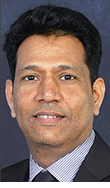CoSci head aims to position dept. as construction partner for space-based initiatives

Patrick Suermann

Manish Dixit

Eric Du
As plans to settle the moon and Mars continue to gather steam among entrepreneurs and corporations, Patrick Suermann, head of the Texas A&M [Department of Construction Science] (http://cosc.arch.tamu.edu) , is laying the groundwork to position the department as a leading research consultant to visionaries shooting, literally, for the moon.
“Any group that hopes to establish a presence on another world is going to need construction partners,” said Suermann. “This department can become a leading research hub to develop building procedures in low and zero gravity environments.”
To open this new avenue for his department, Suermann is forging partnerships with researchers at NASA, the U.S. Air Force and private groups pursuing space-related projects. His efforts included a Nov. 13, 2018, flight with a group of private sector and military researchers aboard a modified Boeing 727 aircraft operated by [Zero Gravity Corporation] (https://www.gozerog.com/) that performed a series of controlled free-fall maneuvers to create microgravity conditions for its passengers.
On the flight, Suermann operated a hand drill on samples that simulate rocks on the moon and Mars in an experiment headed by James Crowell of [Crow Industries] (http://crowindustriesinc.com/) , which develops technology for use in extreme environments. Crowell is aiming to learn how these rocks interact with drilling machinery and how the resulting dust travels in low and zero gravity situations.
Suermann and his fellow researchers wore biometric monitors that recorded data for two construction science faculty members, Manish Dixit and Eric Du, who are developing virtual reality-based simulations to test low and zero gravity’s impact on human spatial cognition, a key factor in the ability to perform basic and high-level tasks in space.
“Future space missions will need interdisciplinary crews with excellent spatial cognition to design, engineer, and construct human habitats,” said Dixit. “These crews may need training that specifically prepares them for extended periods of weightlessness, which can cause disorientation that compromises their health, comfort, and safety.”
Richard Nira
rnira@arch.tamu.edu
Tags
Related Posts

Research, creative work presented at annual symposium
CoSci study finds builders slow to adopt technology

TAMU team uses robot to design complex structure
Follow Us
Facebook Twitter Vimeo Youtube Flickr RSS
Recent Posts

Planning prof heads study of disaster housing aid

A message from the dean

Former student remembered as expert planner

Leading educator named new head of Architecture Dept.






_thumbnail_small.png)
